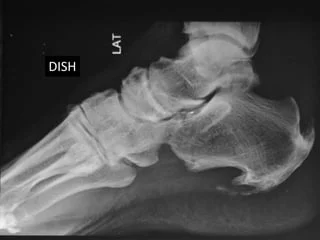
Diffuse Idiopathic Skeletal Hyperostosis (DISH) is a condition in which there is abnormal growth of bone along the sides of the vertebrae of the spine, as well as in other areas of the body, such as the hips, shoulders, knees, and heels. The cause of DISH is unknown, but it is more commonly seen in older adults, particularly those who are overweight or have diabetes.
The excessive growth of bone in DISH can lead to stiffness and pain in the affected areas, as well as difficulty moving. In some cases, DISH can also cause pressure on nearby nerves, leading to additional symptoms such as numbness or tingling.
Diagnosis of DISH is typically made through imaging tests such as X-rays or CT scans, which can show the bony growths. Treatment for DISH usually involves managing symptoms, such as pain and stiffness, with medications or physical therapy. Surgery may be considered in severe cases, particularly if there is nerve compression or other complications.
It is important for people with DISH to maintain a healthy weight, exercise regularly, and manage any underlying health conditions, such as diabetes, to help prevent the progression of the condition. Regular follow-up with a healthcare provider is also recommended to monitor any changes and adjust treatment as necessary.
